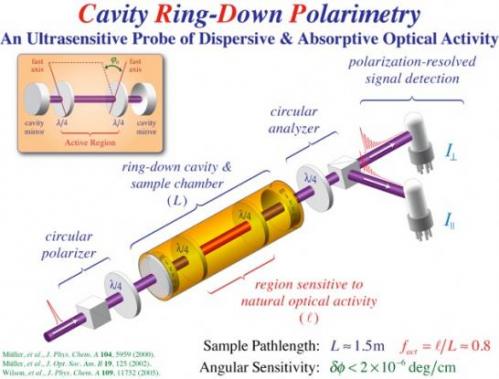Optical Activity of Chiral Molecules
Another area of chemistry that we are currently interested in is the optical activity of chiral molecules. There are two optical manifestations of molecular chirality that can be studied using modern-day polarimetric instruments. The first is optical rotatory dispersion, which is the differential retardation of right-circularly versus left-circularly polarized light as it traverses a medium. The other, circular dichroism, is the differential attenuation of right- circularly versus left-circularly polarized light. The underlying physical process in each case is the same, much like the index of refraction and the absorption coefficient of a material are related. The former manifests itself primarily far off resonance from any absorption bands while the latter dominates near an absorption band. The combination of modern-day computational methods with commercially available and easy-to-use polarimeters has the potential to be a powerful tool for the discrimination between different enantiomers, providing a facile means for establishing the absolute conformation of a molecular system. Despite the wide availability of optical activity data, there are few experimental results that can be accurately compared with burgeoning ab initio predictions. This stems from the fact that, until very recently, the vast majority of polarimetric experiments have been performed in the liquid phase. Solute-solvent interactions can have dramatic effects not only on optical activity, but also on the calculation of optical properties. For this reason gas-phase polarimetric data is desirable. In the gas phase, the inherent optical activity of a molecule can be examined free from the effects of the solvent environment using Cavity Ring-Down Polarimetry (CRDP), a technique invented in our lab. The experimental setup is shown below.

Pulsed UV radiation is spatially filtered and mode matched to the ring-down cavity before traversing a circular polarizer composed of a calcite prism and quarter waveplate. The resulting circularly polarized beam is injected into the cavity through the rear surface of the cavity end mirror. The intracavity quarter waveplates are located such that the active region is about 80% of the total cavity length. The light that emerges from the cavity is imaged onto two photo detectors that monitor orthogonal components of linear polarization generated by the circular polarization analyzer. Using this technique we have able to measure both the circular birefringence and circular dichroism of several chiral molecules. For more information on this work, see the references page of our website.